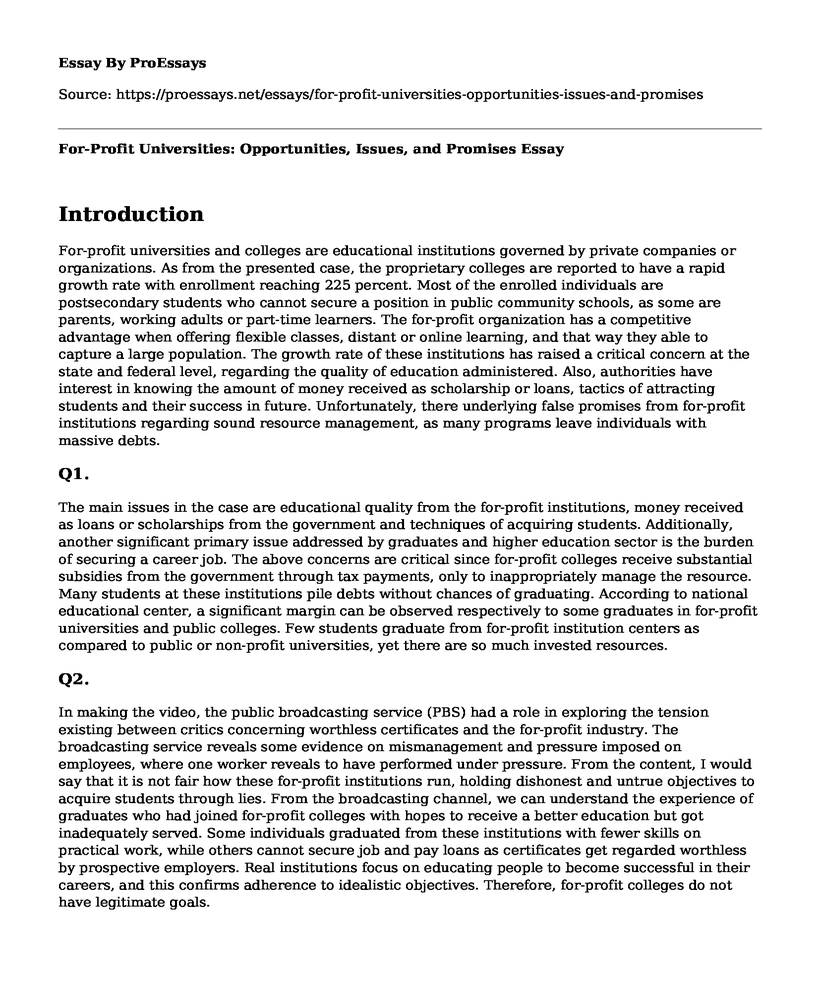Introduction
For-profit universities and colleges are educational institutions governed by private companies or organizations. As from the presented case, the proprietary colleges are reported to have a rapid growth rate with enrollment reaching 225 percent. Most of the enrolled individuals are postsecondary students who cannot secure a position in public community schools, as some are parents, working adults or part-time learners. The for-profit organization has a competitive advantage when offering flexible classes, distant or online learning, and that way they able to capture a large population. The growth rate of these institutions has raised a critical concern at the state and federal level, regarding the quality of education administered. Also, authorities have interest in knowing the amount of money received as scholarship or loans, tactics of attracting students and their success in future. Unfortunately, there underlying false promises from for-profit institutions regarding sound resource management, as many programs leave individuals with massive debts.
Q1.
The main issues in the case are educational quality from the for-profit institutions, money received as loans or scholarships from the government and techniques of acquiring students. Additionally, another significant primary issue addressed by graduates and higher education sector is the burden of securing a career job. The above concerns are critical since for-profit colleges receive substantial subsidies from the government through tax payments, only to inappropriately manage the resource. Many students at these institutions pile debts without chances of graduating. According to national educational center, a significant margin can be observed respectively to some graduates in for-profit universities and public colleges. Few students graduate from for-profit institution centers as compared to public or non-profit universities, yet there are so much invested resources.
Q2.
In making the video, the public broadcasting service (PBS) had a role in exploring the tension existing between critics concerning worthless certificates and the for-profit industry. The broadcasting service reveals some evidence on mismanagement and pressure imposed on employees, where one worker reveals to have performed under pressure. From the content, I would say that it is not fair how these for-profit institutions run, holding dishonest and untrue objectives to acquire students through lies. From the broadcasting channel, we can understand the experience of graduates who had joined for-profit colleges with hopes to receive a better education but got inadequately served. Some individuals graduated from these institutions with fewer skills on practical work, while others cannot secure job and pay loans as certificates get regarded worthless by prospective employers. Real institutions focus on educating people to become successful in their careers, and this confirms adherence to idealistic objectives. Therefore, for-profit colleges do not have legitimate goals.
Q3.
One of the major stakeholders, as mapped in the case, is the Congress- comprise of senates from sectors such as health, education, labor, and pensions committee. The issue addressed by these individuals regard the inappropriate spending of the public fund raised by the taxpayers. The Congress argues that over thirty million dollars taxpayer fund gets allocated to the for-profit institution and requires intense scrutiny on how it is spent. Other stakeholders include students and the media, whose primary issue through testimonies pertains the dishonest education services delivered by a for-profit. I discovered that many individuals especially the less informed are doomed and being misled by institutions whose primary motives are profits gain. I find senator Tom's argument; the ill-practices by for-profit colleges are the norm and systematic in the industry, to be most compelling. From his investigation report, he added that the for-profit institutions have documents of aggressive recruitments unpleasing students result, and taxpayer fund consumed as profit. In my opinion, for-profit colleges do not conduct ethical enrollments and teachings in the desired way, from statistical findings on public expenditure and students' experience or outcomes. As a graduate from a marketable institution, it is expected that one should secure job in an organization that already acknowledge the source of applicant's certificate. The failure to recruit people in the industry implies no school recognition in the job market.
Cite this page
For-Profit Universities: Opportunities, Issues, and Promises. (2022, May 17). Retrieved from https://proessays.net/essays/for-profit-universities-opportunities-issues-and-promises
If you are the original author of this essay and no longer wish to have it published on the ProEssays website, please click below to request its removal:
- Classroom Management Proposal
- Online Adult Education - Essay Sample
- Joshua's Case About Harassment
- In-School Probation Approach in Turning the Youth Away From Crime Paper Example
- Essay on Dealing with Complexity
- Raja Rammohan Roy: Champion of Social Reforms - Essay Sample
- Essay on Early Childhood Education: Crafting a Diverse Curriculum for US Citizens







